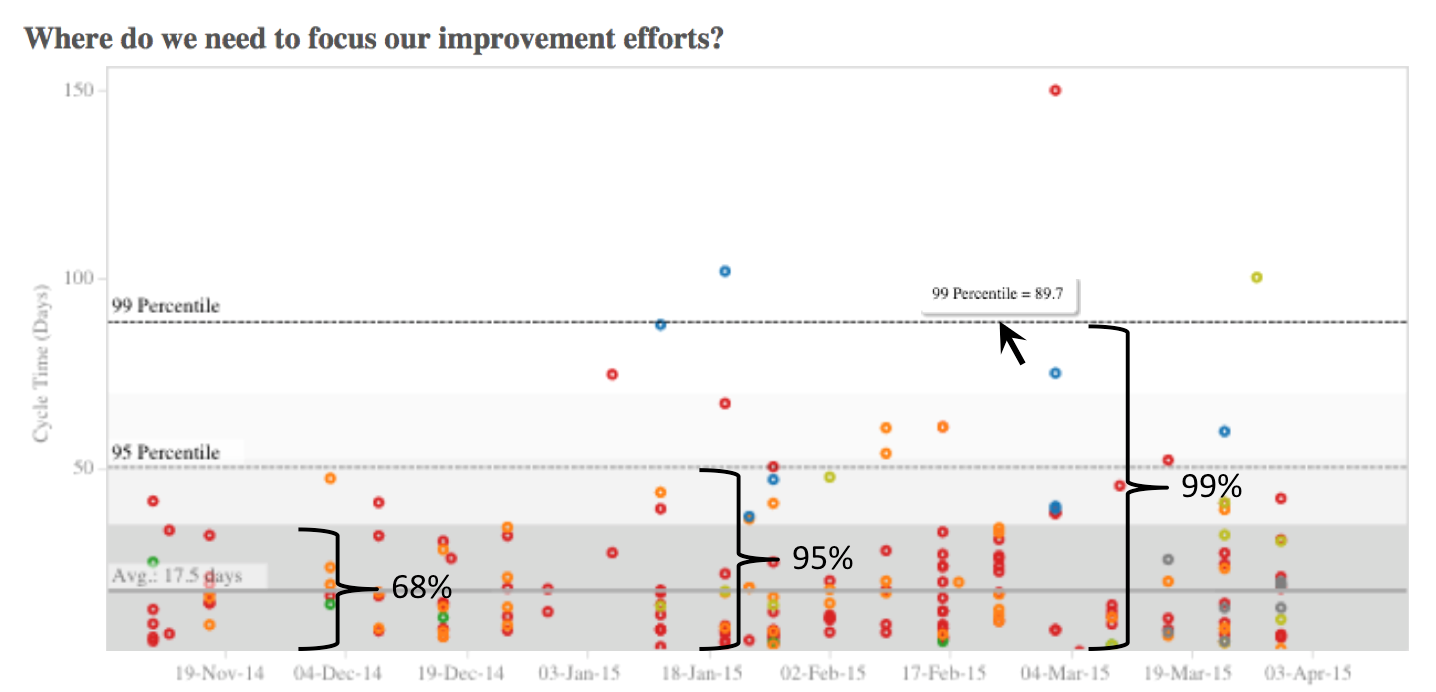
A predictable outcome is one of the most sought-after goals in any business or initiative. It’s easy to see why.
We often correlate predictability with attractive benefits like lower risk, higher business value, and maybe even less stress. So with every new project, we dutifully gather time, effort, and resource estimates from all involved — hoping that this time we’ll nail it.
Except we rarely do.
Fact-Based Predictability with Lean Metrics
Predictability metrics help teams make more accurate estimates about the completion and consistency of their work items. This can lead to better work prioritization and more targeted communications among stakeholders.
"Si vous pouvez prendre des décisions basées sur des faits plutôt que sur des prévisions, vous obtenez des résultats plus prévisibles. Le développement allégé est l'art et la discipline de fonder les engagements sur des faits plutôt que sur des prévisions."
— Mary Poppendieck, Lean Development and the Predictability Paradox (2003)

Teams can use a process control chart to graphically represent their cycle time and completion consistency. The Planview AgilePlace-generated chart above plots a team’s recent work items based on their cycle time. (Note: In this instance, cycle time refers to how many days it took to finish a work item.)
En plus de montrer le temps de cycle moyen de l'équipe (17.5 jours), le graphique comprend trois écarts types pour aider à prédire si l'équipe terminera un élément de travail dans un certain délai :
- 68% of the time, the team will finish a work item within 35.5 days.
- 95% of the time, the team will finish a work item within 54.5 days.
- 99% of the time, the team will finish a work item within 89.7 days.
The key to using a predictability chart is to take the range of possible delivery dates and apply them to your team’s work. Then, when you’re asked to provide an estimate of how long something will take, you can turn to the chart — instead of making an arbitrary guess. With about 70% certainty, you can say that your team can finish a work item in about 36 days. For a higher level of certainty, you know you need to start a work item about 55 days before it must be delivered. In contrast to estimates, using historical date ranges can give teams and their stakeholders a more realistic view of their anticipated cycle time.
Using Predictability Metrics for Continuous Improvement
In addition to more confident timelines, teams can use predictability charts for continuous improvement. For example, data points that fall inside the range of three standard deviations (99% confidence) are often referred to as being “in control.” In-control data points influence the bulk of our day-to-day improvement efforts. We can use them to improve predictability by reducing the range of outcomes.
En utilisant à nouveau le graphique ci-dessus : Si nous pouvons faire passer notre intervalle de confiance de 95 % de 55 à 45 jours, nous obtiendrons une amélioration majeure de la prévisibilité. Nous pouvons alors être plus confiants dans les engagements que nous prenons envers les parties prenantes concernant la livraison d'un travail de qualité. Les moyens d'y parvenir consistent à limiter nos travaux en cours, à passer plus de temps à analyser et à décomposer les éléments de travail en plus petits morceaux, ou à travailler à l'automatisation des processus récurrents.
It can also be useful to analyze the data points that lie outside the range of three standard deviations in a predictability chart. These points are considered “out of control,” but they’re excellent candidates for team retrospectives, lean coffees, or a root cause analysis. Investigating them can help you find ways to improve.
En résumé
Les mesures de prévisibilité peuvent contribuer à améliorer la précision en injectant des faits dans votre analyse. L'utilisation de diagrammes de cohérence d'achèvement vous permet de faire des prédictions plus réalistes sur les résultats potentiels des éléments de travail entrant dans votre système. Cette métrique peut vous aider à mesurer l'effet de vos efforts d'amélioration et vous permettre de vous engager en toute confiance dans des délais raisonnables basés sur des faits, et non des estimations.
Lectures recommandées
- 7 Mesures Lean pour améliorer le débit
- Kanban: How to Get Started with Continuous Improvement (includes four Kanban metrics that any team can track)
- Enhanced Lean Metrics: More Speed and Insight
![Un plan de gestion du travail collaboratif mondial [Vidéo] (en anglais)](https://blog.planview.com/fr/wp-content/uploads/2019/07/A-Global-Collaborative-Work-management-blueprint.png)



